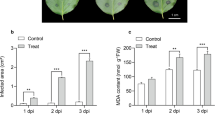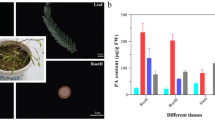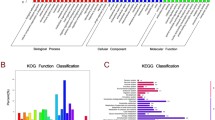Abstract
Differential transcriptome analysis is an effective method for gene selection of triterpene saponin biosynthetic pathways. MeJA-induced differential transcriptome of Panax notoginseng has not been analyzed yet. In this study, comparative transcriptome analysis of P. notoginseng roots and methyl jasmonate (MeJA)-induced roots revealed 83,532 assembled unigenes and 21,947 differentially expressed unigenes. Sixteen AP2/ERF transcription factors, which were significantly induced by MeJA treatment in the root of P. notoginseng, were selected for further analysis. Real-time quantitative PCR (RT-qPCR) and co-expression network analysis of the 16 AP2/ERF transcription factors showed that PnERF2 and PnERF3 had significant correlation with dammarenediol II synthase gene (DS) and squalene epoxidase gene (SE), which are key genes in notoginsenoside biosynthesis, in different tissues and MeJA-induced roots. A phylogenetic tree was conducted to analyze the 16 candidate AP2/ERF transcription factors and other 38 transcription factors. The phylogenetic tree analysis showed PnERF2, AtERF3, AtERF7, TcERF12 and other seven transcriptional factors are in same branch, while PnERF3 had close evolutionary relationships with AtDREB1A, GhERF38 and TcAP2. The results of comparative transcriptomes and AP2/ERF transcriptional factors analysis laid a solid foundation for further investigations of disease resistance and notoginsenoside biosynthesis in P. notoginseng.









Similar content being viewed by others
References
Audic S, Claverie JM (1997) The significance of digital gene expression profiles. Genome Res 7:986–995
Conesa A, Gotz S, Garcia-Gomez JM, Terol J, Talon M, Robles M (2005) Blast2GO: a universal tool for annotation, visualization and analysis in functional genomics research. Bioinformatics 21:3674–3676
Deng B, Huang Z, Ge F, Liu D, Lu R, Chen C (2017) An AP2/ERF family transcription factor PnERF1 raised the biosynthesis of saponins in Panax notoginseng. J Plant Growth Regul 36(3):691–701
Du CF, Hu KN, Xian SS, Liu CQ, Fan JC, Tu JX, Fu T (2016) Dynamic transcriptome analysis reveals AP2/ERF transcription factors responsible for cold stress in rapeseed (Brassica napus L.). Mol Genet Genom 291:1–15
Fujimoto SY, Ohta M, Usui A, Shinshi H, Ohme-Takagi M (2000) Arabidopsis ethylene-responsive element binding factors act as transcriptional activators or repressors of GCC box-mediated gene expression. Plant Cell 12:393–404
Grabherr MG, Haas BJ, Yassour M et al (2011) Full-length transcriptome assembly from RNA-Seq data without a reference genome. Nat Biotechnol 29:644–652
Gu XC, Chen JF, Xiao Y et al (2012) Overexpression of allene oxide cyclase promoted tanshinone phenolic acid production in Salvia miltiorrhiza. Plant Cell Rep 31:2247–2259
He Z, Zhang H, Gao S, Lercher MJ, Chen WH, Hu S (2016) Evolview v2: an online visualization and management tool for customized and annotated phylogenetic trees. Nucleic Acids Res 44(W1):W236–W241
Huang B, Jin L, Liu JY (2008) Identification and characterization of the novel gene GhDBP2 encoding a DRE-binding protein from cotton (Gossypium hirsutum). J Plant Physiol 165(2):214–223
Jovanovski E, Jenkins A, Dias AG et al (2010) Effects of Korean red ginseng (Panax ginseng CA Mayer) and its isolated ginsenosides and polysaccharides on arterial stiffness in healthy individuals. Am J Hypertens 23:469–472
Karmazyn M, Gan XT (2017) Treatment of the cardiac hypertrophic response and heart failure with ginseng, ginsenosides, and ginseng-related products. Can J Physiol Pharmacol 95(10):1170–1176
Kim YJ, Zhang DB, Yang DC (2015) Biosynthesis and biotechnological production of ginsenosides. Biotechnol Adv 33:717–735
Kumar S, Stecher G, Tamura K (2016) MEGA7: molecular evolutionary genetics analysis version 7.0 for bigger datasets. Mol Biol Evol 33(7):1870–1874
Leung KW, Wong AST (2010) Pharmacology of ginsenosides: a literature review. Chin Med 5:20
Liu MH, Yang BR, Cheung WF et al (2015) Transcriptome analysis of leaves, roots and flowers of Panax notoginseng identifies genes involved in ginsenoside and alkaloid biosynthesis. BMC Genom 16:265
Liu H, Pan J, Yang Y, Cui X, Qu Y (2018) Production of minor ginenosides from Panax notoginseng by microwave processing method and evaluation of their blood-enriching and hemostatic activity. Molecules 23(6):1243
Livak KJ, Schmittgen TD (2001) Analysis of relative gene expression data using real-time quantitative PCR and the –ΔCT method. Methods 25:402–408
Lu X, Jiang WM, Zhang L et al (2013a) AaERF1 positively regulates the resistance to Botrytis cinerea in Artemisia annua. PLoS ONE 8:e57657
Lu X, Zhang L, Zhang F et al (2013b) AaORA, a trichome-specific AP2/ERF transcription factor of Artemisia annua, is a positive regulator in the artemisinin biosynthetic pathway and in disease resistance to Botrytis cinerea. New Phytol 198:1191–1202
Luo H, Sun C, Sun Y et al (2011) Analysis of the transcriptome of Panax notoginseng root uncovers putative triterpene saponin-biosynthetic genes and genetic markers. BMC Genom 12(Suppl 5):S5
Ma L, Hu L, Fan J, Amombo E, Khaldun ABM, Zheng Y, Chen L (2017) Cotton GhERF38 gene is involved in plant response to salt/drought and ABA. Ecotoxicology 26(6):841–854
Mayer K, Schüller C, Wambutt R et al (1999) Sequence and analysis of chromosome 4 of the plant Arabidopsis thaliana. Nature 402(6763):769
Moffat CS, Ingle RA, Wathugala DL, Saunders NJ, Knight H, Knight MR (2012) ERF5 and ERF6 play redundant roles as positive regulators of JA/Et-mediated defense against Botrytis cinerea in Arabidopsis. PLoS ONE 7(4):e35995
Moriya Y, Itoh M, Okuda S, Yoshizawa AC, Kanehisa M (2007) KAAS: an automatic genome annotation and pathway reconstruction server. Nucleic Acids Res 35:182–185
Nag SA, Qin JJ, Wang W, Wang MH, Wang H, Zhang R (2012) Ginsenosides as anticancer agents: in vitro and in vivo activities, structure–activity relationships, and molecular mechanisms of action. Front Pharmacol 3:25
Niu Y, Luo H, Sun C, Yang TJ, Dong LL, Huang LF, Chen S (2014) Expression profiling of the triterpene saponin biosynthesis genes FPS, SS, SE, and DS in the medicinal plant Panax notoginseng. Gene 533:295–303
Qi X, Fang H, Yu X et al (2018) Transcriptome analysis of JA signal transduction, transcription factors, and monoterpene biosynthesis pathway in response to methyl jasmonate elicitation in Mentha canadensis L. Int J Mol Sci 19(8):2364
Qiao YJ, Shang JH, Wang D, Zhu H, Yang CR, Zhang YJ (2018) Research of Panax spp. in Kunming Institute of Botany, CAS. Nat Prod Bioprospect 8(4):245–263
Song CP, Agarwal M, Ohta M, Guo Y, Halfter U, Wang PC, Zhu JK (2005) Role of an Arabidopsis AP2/EREBP-type transcriptional repressor in abscisic acid and drought stress responses. Plant Cell 17:2384–2396
Theologis A, Ecker JR, Palm CJ et al (2000) Sequence and analysis of chromosome 1 of the plant Arabidopsis thaliana. Nature 408(6814):816
Van der Fits L, Memelink J (2000) ORCA3, a jasmonate-responsive transcriptional regulator of plant primary and secondary metabolism. Science 289:295–297
Wang CZ, McEntee E, Wicks S, Wu JA, Yuan CS (2006) Phytochemical and analytical studies of Panax notoginseng (Burk.) FH Chen. J Nat Med 60:97–106
Ye J, Fang L, Zheng H et al (2006) WEGO: a web tool for plotting GO annotations. Nucleic Acids Res 34:293–297
Yu ZX, Li JX, Yang CQ, Hu WL, Wang LJ, Chen XY (2012) The jasmonate-responsive AP2/ERF transcription factors AaERF1 and AaERF2 positively regulate artemisinin biosynthesis in Artemisia annua L. Mol Plant 5:353–365
Zhang ZL, Wang WQ, Wang Y, Yang JZ, Cui XM (2010) Influence of Panax notoginseng continuous cropping on seed germination and seedling growth of the plant. Chin J Ecol 29:1493–1497
Acknowledgements
We acknowledge the Beijing Genomics Institute at Shenzhen for its assistance in original data processing and related bioinformatics analysis. This work was supported by the National Key R&D Program of China (2019YFC1711000), National Natural Science Foundation of China (Grant no. 81973414), Fundamental Research Funds for the Central Universities (2632019ZD15), "Double First-Class" University project (CPU2018GY09), Natural Science Foundation of Jiangsu Province (Grant no. BK20140663 and BK20191319) and Postgraduate Research & Practice Innovation Program of Jiangsu Province (KYCX19_0650).
Author information
Authors and Affiliations
Contributions
Conceptualization: PL and XL; investigation: TL, JD and XZ; project administration PZ; writing—original draft preparation, TL; writing—review and editing, XL.
Corresponding authors
Ethics declarations
Conflict of interest
The authors declare that they have no conflict of interest.
Electronic supplementary material
Below is the link to the electronic supplementary material.
Rights and permissions
About this article
Cite this article
Lin, T., Du, J., Zheng, X. et al. Comparative transcriptome analysis of MeJA-responsive AP2/ERF transcription factors involved in notoginsenosides biosynthesis . 3 Biotech 10, 290 (2020). https://doi.org/10.1007/s13205-020-02246-w
Received:
Accepted:
Published:
DOI: https://doi.org/10.1007/s13205-020-02246-w




